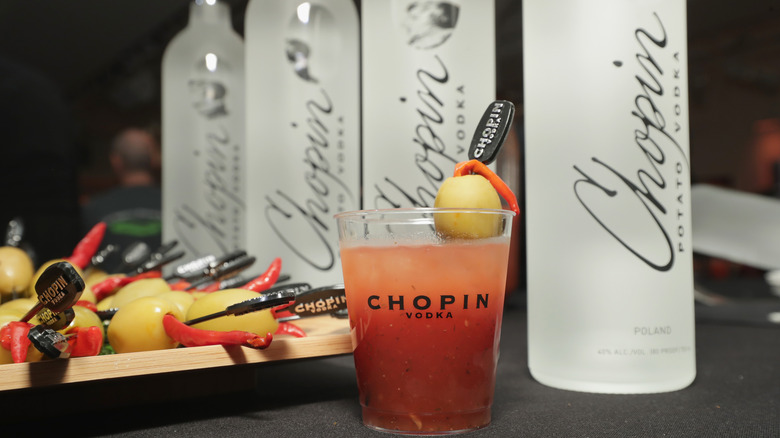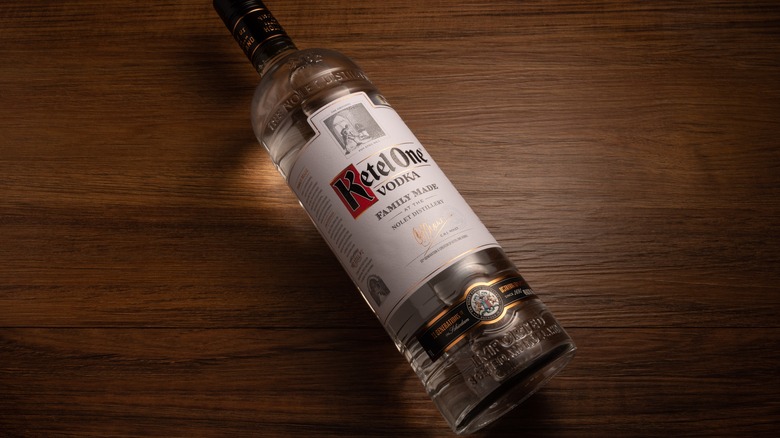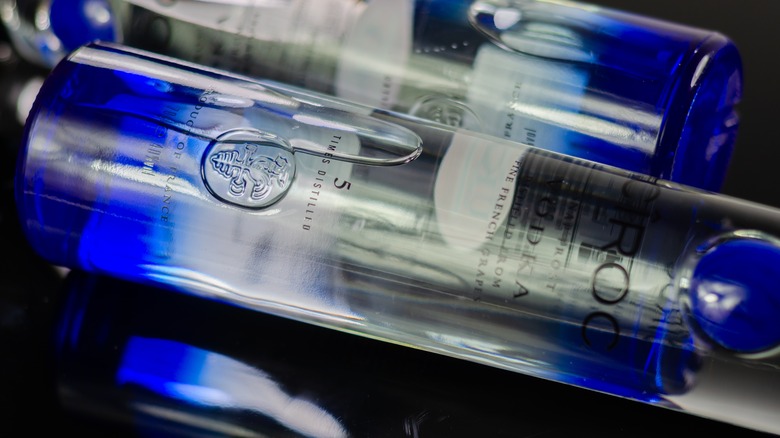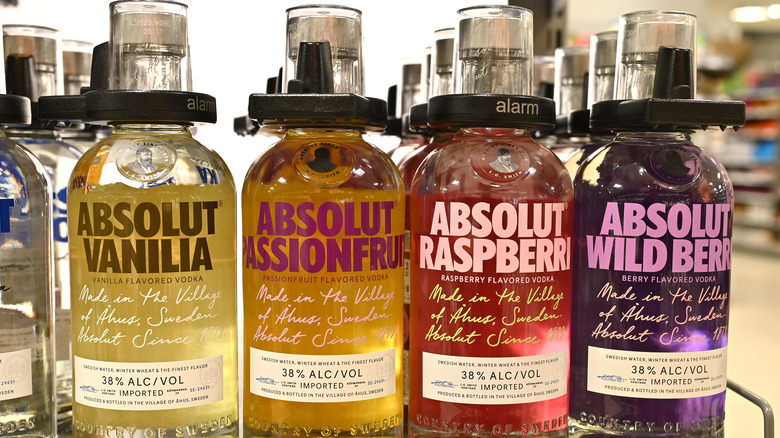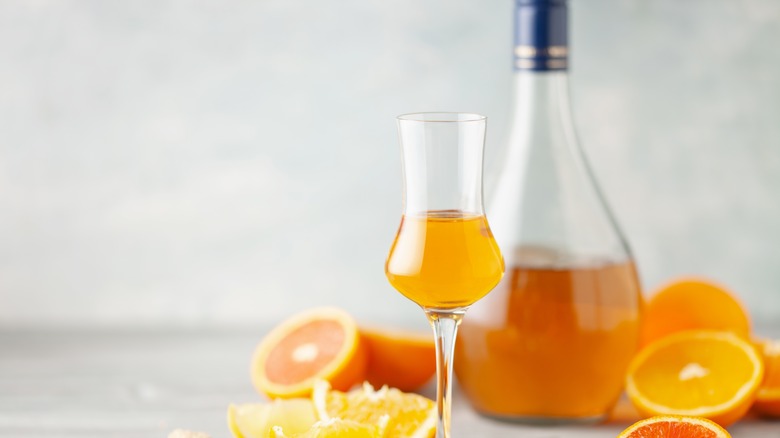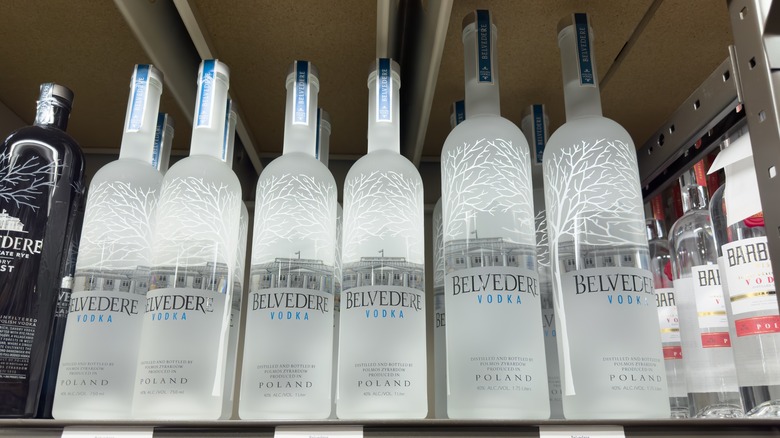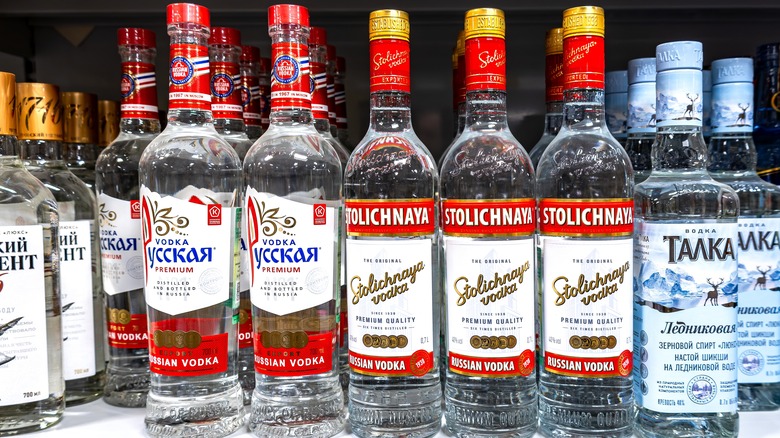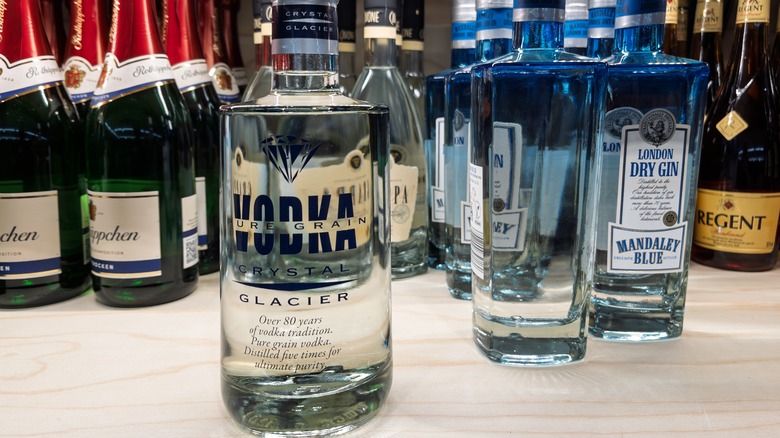14 Types Of Vodka, Explained By Experts
Not too long ago, vodka was defined as a "colorless, odorless, flavorless" spirit, with about as much distinction between brands as you'd expect from liquor that's meant to be akin to water. Now, there are thousands of brands on the market; some with an austere allegiance to tradition, and others that leave such perceptible residual notes on the palate as to defy all traditional vodka denotations.
With so many options, it's perfectly acceptable to simply appoint a best-in-class option and snob all the rest (for this purpose, check out our roundup of the best American vodkas). That said, it pays to know what actually sets vodkas apart beyond the logo. To help you navigate the vast spectrum of vodkas you might encounter on store shelves, we caught up with beverage consultant Jonathan Kleeman, Weber Ranch Vodka's master distiller Antonio Rodriguez, mixologist Nicolette (Nikki) Bonkowski, chief mixologist Molly Horn of Total Wine & More, and vodka specialist Veronika Karlova. Here's what they had to say about what truly distinguishes one vodka from the next.
Plain vodka
If you don't like vodka with too many bells and whistles, then plain vodka is likely already your go-to. Base material choice is largely left to the individual brand's discretion, with a great majority of distillers leaning toward potato, and others opting for corn, rye, wheat, or grape. There's not much of a distinction in terms of distillation technique, though. Plain vodka is first distilled to a 95% to 96% ABV purity, filtered to get rid of impurities, then watered down to achieve the standard 40% ABV.
Multiple distillations are usually necessary to achieve that clean, neutral finish you expect from a plain vodka. Some brands, like Tito's Handmade, even distill the vodkas as many as six times, which, according Jonathan Kleeman, strips the vodka of almost all flavor, "so it becomes so thin and has no real texture."
However, according to Veronika Karlova, there's an upper limit to how pure vodka can get from distillation, "Depending on the type of the still, I'd say after the fifth distillation you won't be able to achieve a greater refinement, and you will be over-distilling." Per Karlova, plain vodkas are heavily favored by mixologists for vodka cocktails, as they have a clean, smooth, almost non-expressive finish, which makes them less likely to cloud other ingredients in a cocktail.
Filtered versus unfiltered vodka
Filtered vodka undergoes filtration to smooth out some of the more aggressive textural notes from the base material and remove impurities. Most vodkas you'll encounter on store shelves have gone through activated carbon filtration, one of the more accessible filtration methods in the industry. However, some distillers might opt for more sophisticated systems like sand, lava rock, or even diamond dust depending on the desired degree of purity and smoothness. According to Antonio Rodriguez, some brands even opt for chilled filtration, where the distillate is chilled to float out impurities, which are then filtered out.
Unfiltered vodka is pretty much antithetical to filtered vodka. While filtered vodkas tend to be pretty aggressive about eliminating all traces of the base material, unfiltered vodkas go the opposite route. "Those same impurities are celebrated. Allowing the natural flavors of the vodkas to shine through and be the bases of the entire Vodka," says Nikki Bonkowski. Bypassing the filtration process tends to create a vodka with a stronger and much more complex flavor profile, per Jonathan Kleeman.
Potato-based vodka
Vodka's not really a stickler when it comes to base material choice. You can pretty much start with anything that's fermentable. There's even a vodka crafted entirely of 100% Blue Weber Agave, courtesy of Weber Ranch Vodka. However, if you're set on staying true to old-world traditions, then look no further than the humble potato.
Not just any potato will do, though. Lean toward potatoes with high starch content and very minimal moisture. The Russet Burbank is a pretty great option if you want to tick both boxes without digging too deep into your wallet. But if you've got a bit more cash on hand, then spring for heirloom or heritage varieties from France, Scandinavia, or Russia — because, why not? From there, your potatoes need to be scrubbed clean, cooked down, and then fermented in water and yeast before they're ready for the still.
And, no, you won't immediately detect hints of potato from the final product. Most vodkas tend to undergo aggressive distillation, which, according to Veronika Karlova, "strips majority of the flavor and character of the raw material used." However, with enough experience, you might become a bit more discerning of base material — like Nikki Bonkowski, who tells us that potato-based vodkas tend to carry "a fuller-bodied flavor; the potato providing a more hearty flavor, still smooth but a little more earthy."
Grain-based vodka
Grains like wheat, corn, rye, and even sorghum are pretty solid base materials in the vodka business. Like potatoes, they allow you to maintain that coveted austerity to tradition, but are far more amenable to scaling. So it's not really a wonder that a lot of vodka brands on the market, even top-shelf ones you'd likely order for bottle service — think Grey Goose, Ketel One, Belvedere — are all grain-based. The production process mirrors that of potato vodka, with one key difference: The grains are first mashed to extract fermentable sugars before fermentation kicks in.
Textural and flavor differences between grain types are subtle — and you might not catch them right off the bat — but they're there if you know what to look for. Molly Horn has an interesting way of distinguishing between grain-based vodkas that might come in handy. "If you are looking at grain-based vodkas as an example, I like to use the comparison of bread: wheat bread is mild with a little touch of cereal malt — just like wheat-based vodkas. Rye bread is sharp and peppery, similar to rye-based vodkas. Cornbread is sweet and almost fruity, like many corn-based vodkas," she says.
Horn recommends a use-case approach to discerning which grain type should go into a cocktail. "If I'm making an Extra Dry Vodka martini, I'd go with a Winter Wheat-based vodka (Grey Goose), whereas if I were going for a Dirty Martini I would reach for a rye-based vodka like Belvedere (that spiciness is deliciously savory with the olive brine!). I love a corn-based vodka for a Mule, since the tart spice of the ginger beer plays nicely with the hint of citrus and sweeter overall character of that type of vodka," she says.
Fruit-based vodka
For a long time, markets around the world were flooded with vodkas so inert they barely left an impression on the palate. It was pretty much the norm to distill vodka to oblivion, and heavy hitters like Smirnoff and Absolut were constantly tripping over each other in marketing campaigns over who could do it most aggressively.
Things have changed quite a bit since then. Neutrality doesn't exactly command the same reverence it once did, and inert vodka is slowly losing top-dog status. Among those gunning for the top spot are fruit-based vodkas; a category that ditches old-world base preferences like potato, wheat, corn, and rye in favor of eau-de-vie-style choices like grape, pear, cherry, and even apple.
According to Nikki Bonkowski, fruit-based vodkas often carry a noticeable sweetness, thanks to the floral undertones left about by the fruit. You can work them into a cocktail if you like a spirit that doesn't try too hard to disappear. And while neutrality is preferred by many for sipping, fruit-based vodka can also be a great sipping option for the adventurous palate. "As I tell all my guests that come into the bar, the best brands are whichever you find fit your palate the best. All styles of vodkas are meant to be sipping vodkas," says Bonkowski.
Flavored vodka
Sure, neutrality isn't a prominent factor when making fruit-based vodka, but even with those, you have to really be looking to detect the floral top note. Flavored vodka, on the other hand, takes the idea of adding character and flavor to your vodka to a whole new — some might say extreme — level.
Here, you've got your pick of flavors; mango, coffee, tiramisu, whipped cream, salted caramel — you name it, they probably have it in stock in a backlit bar somewhere. Natural flavoring is preferred and prized.
However, as Total Wine's Molly Horn points out, reliance on artificial flavoring and high-fructose corn syrup is pretty common in this category; the cloying sweetness often acting as a crutch for a subpar base, which is how you get flavored vodka that tastes syrupy sweet but burns like window cleaner. There are some standout exceptions, though, like the Deep Eddy line, which, according to Horn, features "real ingredient flavored vodkas that taste like homemade infusions — but with professional polish and consistency."
Infused vodka
Stirring in artificial or natural flavoring after distillation is economical, saves time, yields consistent flavor from bottle to bottle, and doesn't affect the final product's shelf life. In essence, it's a great option for a mass distiller.
There's another way, though: Infusion, where, according to Molly Horn, "whole ingredients (like fruits, herbs, or spices) are steeped in vodka to extract their flavor, somewhat akin to steeping tea." Think of infused vodka as flavored vodka's more sophisticated cousin, who's — as Horn tells us — a bit more of a stickler for "artisanal, small-batch quality and a more handmade feel."
While those standards might make it sound like some feat of chemical engineering, it's really not; you can even infuse your vodka at home. But as Horn points out, the process is painstakingly slow and lacks "the scalability and consistency of professionally flavored vodkas," so it's unlikely that you'll go from infusing your vodka with horseradish one day to launching a full line of craft vodkas the next. Still, infusions are a great way to layer your vodka with flavor without having to roll the dice on that suspiciously cheap bottle of flavored hooch.
Craft vodka
Like many spirits that go against old-world norms, craft vodka is pretty new to the scene; only about a decade old, according to Veronika Karlova. Much like what happened with whiskey and gin, the craft movement has had an incredibly disruptive effect on vodka, and there's growing speculation that it could completely reshape how consumers think about vodka.
It's not exactly a mystery why: Craft vodka thumbs its nose at almost all the trademark elements of the vodka industry. Per Jonathan Kleeman, craft distillers don't just hop on any fermentable base. There's a lot more discernment involved, with many leaning toward locally-sourced, homegrown organic materials. Craft vodka distillers also seem particularly averse to making vodka that tastes like nothing, so lightly filtered or even unfiltered vodkas tend to dominate the scene. One old-world tradition still prevails, though: multiple distillations. But even then, it's never done so aggressively that it erases the character or texture of the base.
Terrior-driven vodka
Yet another wave that's turning the tide in the vodka industry is terroir. Veronika Karlova tells us that terroir in vodka is a lot more elusive than with wine, whose terroir is much more readily discernible on the palate. But that doesn't mean that the idea of terroir in vodka is just marketing hogwash. Per Jonathan Kleeman, using locally sourced base materials is a big way for distillers to achieve terroir, as these bases usually retain the minerality and textural subtleties of the place of origin.
Another avenue that vodka distillers leverage to evoke terroir is water source, and for a product that's 60% water, the kind and quality of water used is bound to make a huge difference in the final product. "Limestone-filtered water and water from a local aquifer both contribute to a crisp, smooth vodka, but in different ways with subtle flavor differences," says Molly Horn. Case in point: Stolichnaya's take on terroir-driven vodka, Stolichnaya Elit, achieves terroir by sourcing its waters from exclusive enclaves like the Himalayas, the Andes Mountains, and New Zealand's Blue Spring, all known for their pristine waters.
Slavic style vodka
Though the market is flooded with sundry vodka brands, not many can truly hold a candle for something bred with the frost and muscle of Eastern Europe. Here, you'll find bottles that, while true to the ye olde tradition of vodka being a clean, near-flavorless spirit, still manage to pull off character and texture; not with infusions of artificial flavoring, but by not trying too hard to hide the textural nuances of the base material.
Base material choice is pretty austere to old-world Slavic traditions, with potato and rye dominating the scene. That said, it's not entirely unorthodox to encounter wheat-based varieties. After all, Russian varieties like Russian Standard and Stolichnaya are made from wheat, but still as Slavic as it gets. Filtration is kept at a minimum — three or four rounds typically suffice for most brands — so the textural nuances of the base are unlikely to get scrubbed out. Jonathan Kleeman tells us that Slavic-style vodka, while not nearly as experimental as craft vodka, is still boldly expressive, boasting full-bodied mouthfeel and earthy overtones.
Scandinavian style vodka
Think of Scandinavian vodka as Slavic vodka's more minimalist neighbor. Not in reach, though; Sweden is still the world's leading exporter of vodka, after all. A Slavic-style bottle is very present on the palate (unless you're, say, a quarter of the way through, then your taste buds — if you retain any at all — will summarily dismiss such academic pronouncements). A Scandinavian one, on the other hand, is far more stoic; not sterile, just unlikely to say anything unless it's really important.
Here, base material is chosen more for neutrality than expression. Winter wheat and barley are the usual suspects, though it's common for the mash to go through as many as three to four distillations; aggressive, but ideal for a vodka that's not going to try too hard to assert itself. Textural nuances still matter, though they're achieved less through base choice and more through mineral-rich water sources. Jonathan Kleeman tells us that Scandinavian-style vodka is far more subtle on the palate, with a clean, crisp, somewhat dry finish.
American vodka
Forget staunch Slavic tradition and the clean lines and precision of Scandinavia — things happen a lot differently in the good ol' U.S.A. For one, base choice is far more democratic, some would say to an almost egregious extent. Though expected options like corn and wheat still dominate, Veronika Karlova tells us it's common for New World distillers to experiment with unorthodox base materials like grape, whey, and fruit. American distillers give themselves somewhat of a free rein when it comes to said experimentation; milk sugar, apples, honey, quinoa — pretty much anything fermentable is fair game.
The legal landscape is far less restrictive than in Europe. Additives like sugar and citric acid are permitted, and distillers have a lot more discretion over distillation/filtration techniques. So you're likely to encounter bottles with all manner of textural and flavor nuances on store shelves. Still, as Jonathan Kleeman points out, most American distillers still insist on treating vodka like a blank canvas just hankering to come alive in a cocktail, so bottles with clean, neutral, almost inert finishes dominate the market.
Premium/ultra-premium vodka
Not all vodka is made the same, and nobody is ever so keen on rubbing that in as a distiller who makes premium or ultra-premium vodka. It's not completely without merit. Premium vodkas are precisely distilled from top-of-the-line base materials, filtered just right, and watered down with pristine waters. Jonathan Kleeman tells us that vodka in the premium/ultra-premium clan has a pretty distinctive tell, "The smell on the nose is more delicate and doesn't deliver strong alcohol notes."
As for utility, premium and ultra-premium brands are pretty versatile, "enough to be enjoyed on the rocks, sipped in a martini, or as the base of any number of inventive cocktails," says Antonio Rodriguez. The price point is, more often than not, aggressively unapproachable. Some ultra-premium labels tote price tags as high as $3 million (Billionaire vodka). Others are far more forgiving, with bargain prices of, say, $7,000 (Belvedere Bears). Though, as Molly Horn points out, it's still possible to get premium-quality vodka without breaking the bank; Deep Eddy, Tito's Handmade, and Absolut being notable exceptions to the "you get what you pay for" rule.
Budget-tier vodka
Bold, expressive flavor notes, textural subtleties, velvety finishes; all things you'd expect if you drop, say, $3,000 on a luxury hooch. Things get a lot more dicey if your budget has two fewer zeros and also needs to cover party favors. Don't be mistaken; a vodka bought in such dire circumstances will still get the job done — if the job's partial amnesia. But as Molly Horn tells us, most vodkas in the budget tier "lack the smoothness of their premium counterparts," so maybe prepare for a coughing fit if you dare to sip it neat.
Veronika Karlova adds that sourcing raw materials is often a battle for most distillers, so budget-tier distillers are likely to lean on cheap, scalable bases like high fructose corn syrup or bulk grain. Distillation is also likely to be a patchwork job, yielding a pretty insecure base spirit that needs to be propped up with lots of artificial flavoring and sweetener not to qualify as antiseptic. Horn also points out that it's unlikely you'll get a clean finish from a cocktail made with a budget-tier vodka, unless, of course, it's been mixed rather aggressively.




